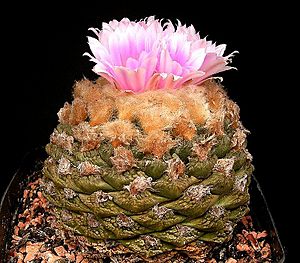Living rock cactus facts for kids
Quick facts for kids Living rock cactus |
|
|---|---|
 |
|
| Conservation status | |
| Scientific classification | |
| Genus: |
Ariocarpus
|
| Species: |
fissuratus
|
| Synonyms | |
|
Mammillaria fissurata Engelm. |
|
Ariocarpus fissuratus is a special type of cactus. It is sometimes called the living rock cactus because it blends in so well with its surroundings. Other common names include false peyote, chautle, dry whiskey, and star cactus.
You can find this unique cactus in small numbers. It grows in northern Mexico and in Texas in the United States.
Contents
What is Ariocarpus fissuratus?
This cactus has many small bumps called tubercles. These tubercles grow from a large, deep tap root that helps the plant find water.
Most of the time, you will find just one cactus growing by itself. It rarely grows new shoots from its older parts. The plant is usually a grayish-green color. As it gets older, it might turn a bit yellowish.
How does it grow?
Ariocarpus fissuratus grows extremely slowly. It is naturally camouflaged, meaning it blends in perfectly with the rocks and soil where it lives. This makes it very hard to spot!
You might only notice it when its pretty pink flowers bloom. These flowers usually appear in October and early November.
Growing Ariocarpus fissuratus
When people grow Ariocarpus fissuratus, they sometimes use a special method called grafting. This means attaching a piece of the Ariocarpus fissuratus to another, faster-growing cactus. This helps the plant grow much quicker. If left on its own, it could take more than ten years to become fully grown.
This cactus does not need much water or plant food. It likes a lot of sunlight. It also needs loose, sandy soil that drains water well. This helps prevent its roots from rotting.
Protecting Ariocarpus fissuratus
This cactus is a protected species, especially in Texas. Sadly, many of these protected cacti are taken from their natural homes without permission each year. This is a big problem.
Even places like Big Bend National Park have seen large numbers of these cacti removed. Some people take them mainly for collectors, especially in Europe and Asia. When so many plants are taken, it reduces the different types of genes within the species. This can make it harder for the cactus to survive in the future.
The U.S. Department of Justice states that this cactus is protected by an important agreement. This agreement is called the Convention on International Trade in Endangered Species of Wild Fauna and Flora (CITES). CITES helps control the trade of endangered plants and animals around the world.
Traditional Uses
Historically, Ariocarpus fissuratus has been used by some Native American tribes for special purposes. It was sometimes used as a substitute for another cactus called peyote in traditional ceremonies.
Scientists have studied Ariocarpus fissuratus to understand what it contains. They found that it has very tiny amounts of certain natural substances, like N-methyltyramine and hordenine. However, these amounts are so small that they are not active. This means they do not have any noticeable effects.
See also
 In Spanish: Ariocarpus fissuratus para niños
In Spanish: Ariocarpus fissuratus para niños


